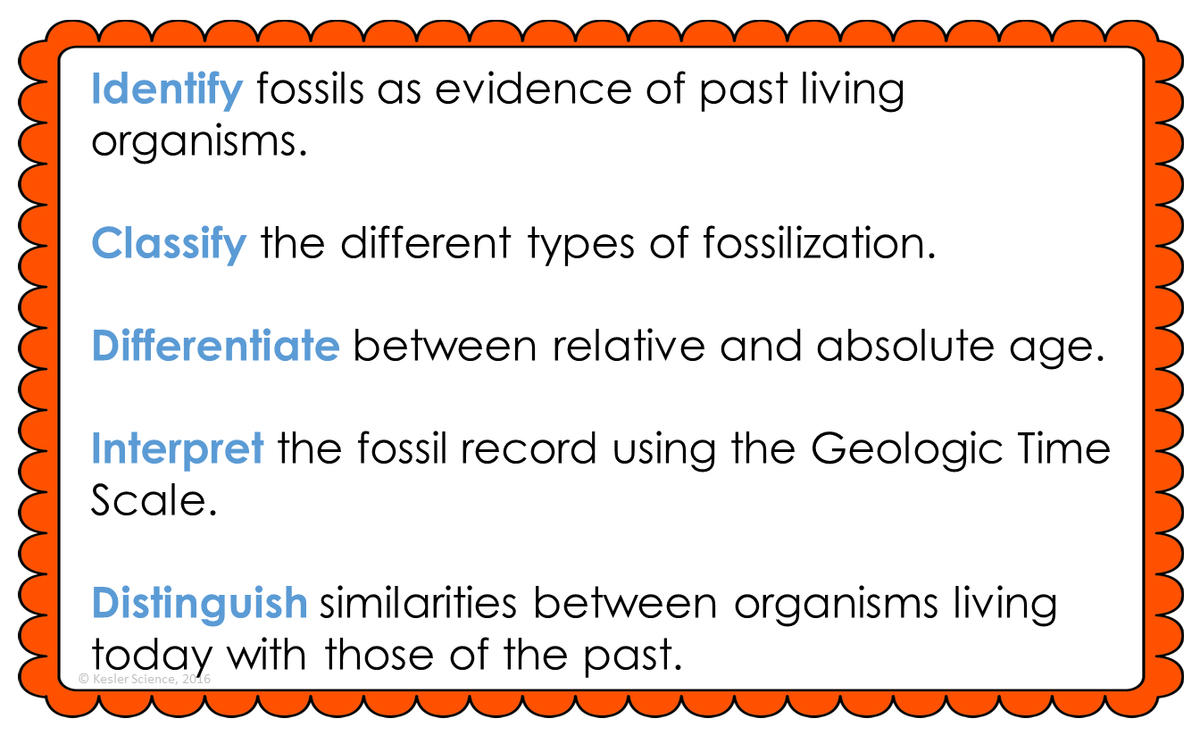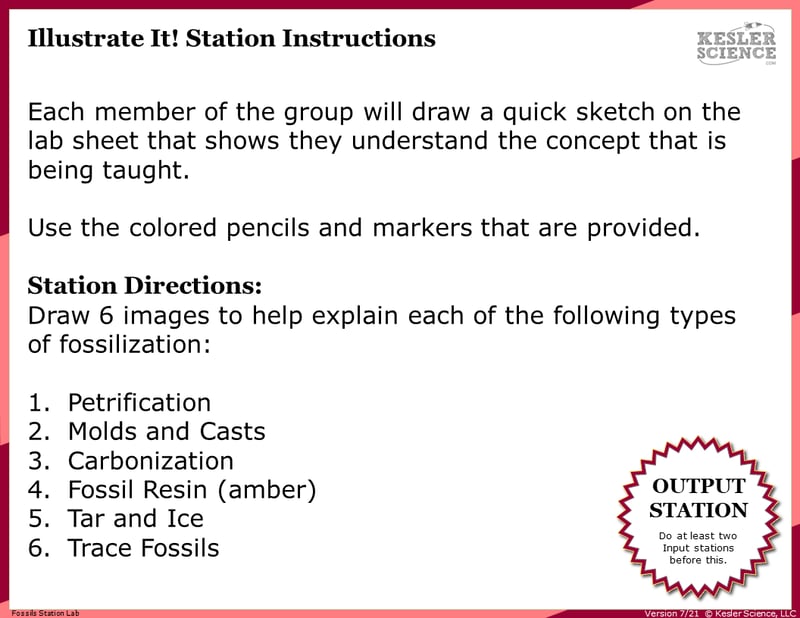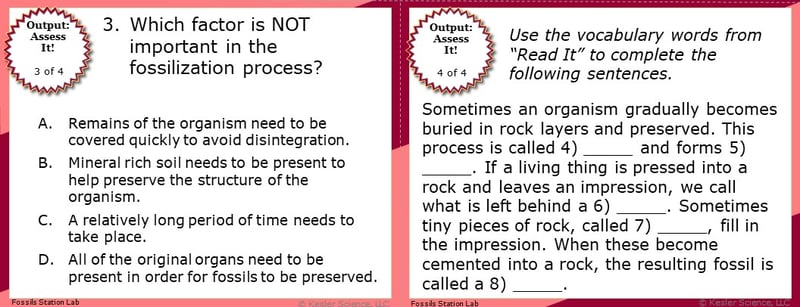Fossils Lesson Plan – A Complete Science Lesson Using the 5E Method of Instruction
By the end of this lesson about fossils, students will be able to identify fossils as evidence of past living organisms, classify the different types of fossilization, differentiate between relative and absolute age, interpret the fossil record using the Geologic Time Scale, and distinguish similarities between organisms living today with those of the past. Each of our lessons is designed using the 5E method of instruction to ensure maximum comprehension by the students. This well-thought out unit does the heavy lifting, giving teachers easy-to-implement, highly engaging lesson plans.
This blog will walk you through each of the steps and activities from the Fossils 5E Lesson Plan.
ENGAGEMENT
Objective Introduction
At the beginning of the lesson, the class will do a Think-Pair-Share to discuss the objective.
Class Activity
- Generate a list of vocabulary students already know about fossils.
- Ask students, “What do fossils tell us about the past?”
- While students are watching the video, ask them if they can “catch” the way fossils are formed and write down any vocabulary they see or hear.
Student Activity
- Discuss with a partner some ideas and concepts they learned from the video.
- Have a whole group discussion about their ideas.
- Rewatch the video and look more closely for the vocabulary that was previously discussed and the way fossils form.
- Discuss additional information from the video.
- Tell students they will be learning how fossils form, their importance in geologic history, and what they can tell us about past environments.

The teacher will then help to clear any misconceptions their students have about fossils. A common but major misconception, for example, is that students probably think all fossils form in the same way.
Estimated Class Time for the Engagement: 20-30 minutes
EXPLORATION
This student-centered station lab is set up so students can begin to explore fossils. Four of the stations are considered input stations where students are learning new information about fossils and four of the stations are output stations where students will be demonstrating their mastery of the input stations. Each of the stations is differentiated to challenge students using a different learning style. You can read more about how I set up the station labs here.
Watch It!
At this station, students will be watching a short video explaining what a paleontologist does. Students will then answer some questions relating to the video and record their answers on their lab station sheet. For example: According to the video, what is a fossil? What are some of the roles of a paleontologist? Why do you think it’s important for humans to study fossils?
Read It!
This station will provide students with a one-page reading about Jurassic Park and DNA. In the reading, students will learn how the scientists in the movie collected DNA from mosquitoes trapped in amber. Students will also learn about how scientists today are able to date how long ago an organism lived by looking into the leg bones. There are four follow-up questions that the students will answer to demonstrate their comprehension of the reading material.
Explore It!
Students will be working in pairs to better understand fossils. Students will be examining a number of cards that show fossils that have been cast in many different ways. Students will record their observations on their lab sheet.
Research It!
The research station will allow students to find out information about …. swf file
Write It!
Students who can answer open-ended questions about the lab truly understand the concepts that are being taught. At this station the students will be answering three task cards: Describe how an organism could become a fossil. Describe three roles a paleontologist performs in their job. Describe two ways a fossil could be created.
Illustrate It!
Your visual students will love this station. Students will sketch six images to explain different types of fossilization.

Organize It!
The Organize It station allows your students to organize the type of fossilization to an image that matches.
Assess It!
The Assess It station is where students will go to prove mastery over the concepts they learned in the lab. The questions are set up in a standardized format with multiple choice answers. Some questions include: What type of fossil is a student inspecting that is completely encased in an orange substance? Which is not a role of a paleontologist? Which factor is not important in the fossilization process? Which is not an example of a trace fossil?

Challenge It! - Bonus Station
Early finishers and advanced students will love the extension activities in this station. Four activity choices offer them ways to expand their learning through mini-games and mini-projects.
Estimated Class Time for the Exploration: One or two 45-minute class periods
EXPLANATION
The explanation activities will become much more engaging for your class once they’ve completed the exploration station lab. During the explanation piece of the lesson, the teacher will be clearing up any misconceptions their students may have about fossils with a variety of materials. These materials include on-level and modified versions of the interactive presentation (may be used individually or projected), anchor charts, and paper or digital interactive notebook activities. If you have students that need modified notes, the 5E lessons come equipped to help give every student access to the lesson.
The students will also be interacting with their journals using INB templates for fossils. Each INB activity is designed to help students compartmentalize information for a greater understanding of the concept. The fossils INB templates allow students to focus their notes on the types of fossilization.
Estimated Class Time for the Exploration: Two or three 45-minute class periods
ELABORATION
The elaboration section of the 5E method of instruction gives students choices that allow them to prove they’ve mastered the concepts behind the lesson. When students are given a choice, they’re much more enthusiastic and invested in the project than they are when their teachers choose their projects for them. There are a total of nine choices to demonstrate understanding of fossils. A separate set of choices that offer more teacher support are also available for students that need them. Rubrics guide students to doing their best work and assist in grading.

Estimated Class Time for the Elaboration: Two or three 45-minute class periods (can also be used as an at-home project)
EVALUATION
The final piece of the 5E model is to evaluate student comprehension. Included in every 5E lesson is a homework assignment, assessment, and modified assessment. Research has shown that homework needs to be meaningful and applicable to real-world activities in order to be effective. When possible, I like to give open-ended assessments to truly gauge the student’s comprehension.
Estimated Class Time for the Elaboration: One 45-minute class period
DOWNLOAD THE FULL LESSON NOW
Download Over $100 in FREE Resources
For Middle School Science
Simply create a login below and gain immediate access to a selection of our Kesler Science product line worth $100 - for FREE. There's a full version of every product type! You'll also join tens of thousands of middle school science teachers who receive timely tips and strategies straight to their inbox.







